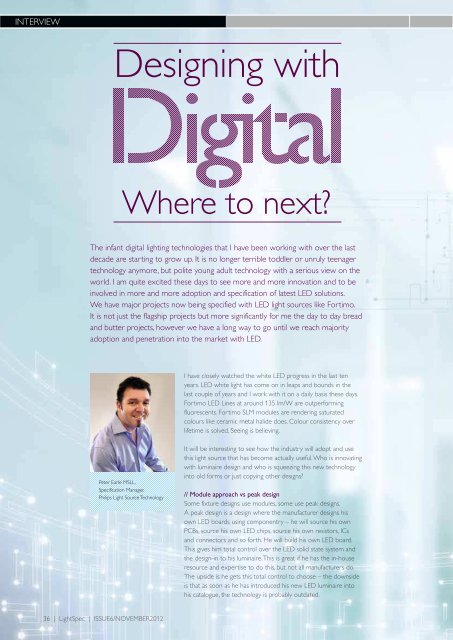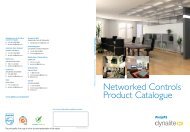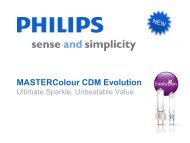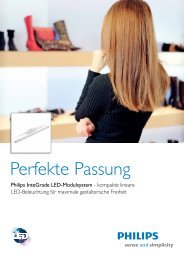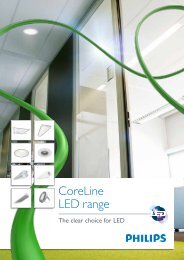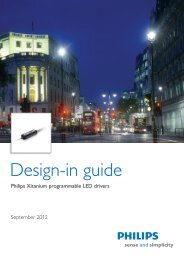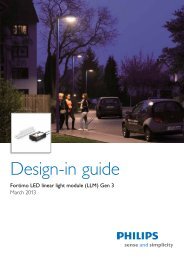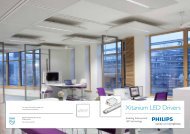Quality of light and the - Philips Lighting
Quality of light and the - Philips Lighting
Quality of light and the - Philips Lighting
Create successful ePaper yourself
Turn your PDF publications into a flip-book with our unique Google optimized e-Paper software.
iNtERViEW<br />
Designing with<br />
Where to next?<br />
<strong>the</strong> infant digital <strong>light</strong>ing technologies that i have been working with over <strong>the</strong> last<br />
decade are starting to grow up. it is no longer terrible toddler or unruly teenager<br />
technology anymore, but polite young adult technology with a serious view on <strong>the</strong><br />
world. i am quite excited <strong>the</strong>se days to see more <strong>and</strong> more innovation <strong>and</strong> to be<br />
involved in more <strong>and</strong> more adoption <strong>and</strong> specification <strong>of</strong> latest LED solutions.<br />
We have major projects now being specified with LED <strong>light</strong> sources like Fortimo.<br />
it is not just <strong>the</strong> flagship projects but more significantly for me <strong>the</strong> day to day bread<br />
<strong>and</strong> butter projects, however we have a long way to go until we reach majority<br />
adoption <strong>and</strong> penetration into <strong>the</strong> market with LED.<br />
Peter Earle MsLL,<br />
specification Manager,<br />
<strong>Philips</strong> Light source technology<br />
I have closely watched <strong>the</strong> white LED progress in <strong>the</strong> last ten<br />
years. LED white <strong>light</strong> has come on in leaps <strong>and</strong> bounds in <strong>the</strong><br />
last couple <strong>of</strong> years <strong>and</strong> I work with it on a daily basis <strong>the</strong>se days.<br />
Fortimo LED Lines at around 135 lm/W are outperforming<br />
fluorescents. Fortimo SLM modules are rendering saturated<br />
colours like ceramic metal halide does. Colour consistency over<br />
lifetime is solved. Seeing is believing.<br />
It will be interesting to see how <strong>the</strong> industry will adopt <strong>and</strong> use<br />
this <strong>light</strong> source that has become actually useful. Who is innovating<br />
with luminaire design <strong>and</strong> who is squeezing this new technology<br />
into old forms or just copying o<strong>the</strong>r designs?<br />
// Module approach vs peak design<br />
Some fixture designs use modules, some use peak designs.<br />
A peak design is a design where <strong>the</strong> manufacturer designs his<br />
own LED boards using componentry – he will source his own<br />
PCBs, source his own LED chips, source his own resistors, ICs<br />
<strong>and</strong> connectors <strong>and</strong> so forth. He will build his own LED board.<br />
This gives him total control over <strong>the</strong> LED solid state system <strong>and</strong><br />
<strong>the</strong> design-in to his luminaire. This is great if he has <strong>the</strong> in-house<br />
resource <strong>and</strong> expertise to do this, but not all manufacturers do.<br />
The upside is he gets this total control to choose – <strong>the</strong> downside<br />
is that as soon as he has introduced his new LED luminaire into<br />
his catalogue, <strong>the</strong> technology is probably outdated.<br />
An LED module is basically an LED chip package encased in a<br />
module body that allows it to be easily fixed into a luminaire.<br />
With less technical challenges than a peak design, <strong>the</strong> designer<br />
can reach production prototype stage <strong>and</strong> product launch more<br />
quickly. If <strong>the</strong> module supplier also supplies drivers <strong>and</strong> cables,<br />
provides detailed technical design-in guides <strong>and</strong> recommends<br />
o<strong>the</strong>r component suppliers for items like reflectors <strong>and</strong> <strong>the</strong>rmal<br />
solutions, <strong>and</strong> say a system warranty for 5 years for instance, <strong>the</strong>n<br />
<strong>the</strong> luminaire manufacturer has all <strong>the</strong> means <strong>and</strong> comfort he<br />
needs to launch a great LED fixture portfolio that will st<strong>and</strong> <strong>the</strong><br />
test <strong>of</strong> time.<br />
I am concerned by people who say <strong>the</strong>y are concerned about <strong>the</strong><br />
module approach. They may think <strong>the</strong> module approach is about<br />
squeezing a new technology into an old format. In fact I think <strong>the</strong>y<br />
might be missing <strong>the</strong> point or have a different agenda. A modular<br />
approach helps to future-pro<strong>of</strong> a design <strong>and</strong> <strong>of</strong>fer design freedom.<br />
We know that LED technology is improving at a<br />
fast rate, so if a luminaire is designed toge<strong>the</strong>r<br />
with its LED board <strong>and</strong> electronics as<br />
an inseparable unit, a peak design,<br />
<strong>the</strong>n <strong>the</strong> LED technology inside that<br />
luminaire quickly becomes out <strong>of</strong> date.<br />
If <strong>the</strong> luminaire maker tools up for a<br />
modular approach, <strong>and</strong> <strong>the</strong> module<br />
technology improves every 6 months,<br />
<strong>the</strong>n <strong>the</strong>re is no need to retool <strong>the</strong> fixture<br />
line to upgrade <strong>the</strong> <strong>light</strong> source to <strong>the</strong> next<br />
generation. And as <strong>the</strong> <strong>light</strong> source supplier innovates<br />
<strong>and</strong> releases better <strong>and</strong> better module <strong>and</strong> system technology,<br />
that innovation is passed on to its customers, <strong>the</strong> luminaire<br />
manufacturers, for no extra cost. How good is that?<br />
Kristian Krogh, co-founder <strong>of</strong> EQ2<strong>light</strong>, a London-based <strong>light</strong>ing<br />
design company with global clients, comments: “Our customers<br />
are becoming increasingly aware <strong>of</strong> LED <strong>and</strong> <strong>the</strong> advantages <strong>of</strong><br />
LED schemes. Toughening energy legislation <strong>and</strong> smart salesmen<br />
have led <strong>the</strong>m to LED for some years. However, as some <strong>of</strong> <strong>the</strong>se<br />
older installed schemes mature, some have shifted (in colour) <strong>and</strong><br />
malfunctioned. So whilst many <strong>of</strong> our customers are still open<br />
to LED schemes most are not intending to wed <strong>the</strong>mselves to<br />
one manufacturer for <strong>the</strong> next ‘50,000 hours’. They are <strong>the</strong>refore<br />
keen to have <strong>the</strong> opportunity to replace <strong>the</strong> LEDs with ano<strong>the</strong>r<br />
manufacturer’s units if this becomes necessary.”<br />
Kristian summarises: “Modularity will start to <strong>of</strong>fer this possibility,<br />
whilst we are perhaps not quite <strong>the</strong>re yet, <strong>the</strong> idea that we can<br />
swap units as simply as swapping a Decostar for a Masterline<br />
is not only appealing but necessary. This will <strong>of</strong>fer <strong>the</strong> ‘apples<br />
for apples’ comparison <strong>and</strong> start to eek out <strong>the</strong> less factual<br />
manufacturers, turning <strong>the</strong> wild west LED revolution into an<br />
underst<strong>and</strong>able <strong>and</strong> accountable market place for <strong>light</strong>ing<br />
pr<strong>of</strong>essionals as well as end users.”<br />
// St<strong>and</strong>ardisation?<br />
It is clear <strong>the</strong>re is no st<strong>and</strong>ard industry method <strong>of</strong> getting <strong>the</strong> LED<br />
<strong>light</strong> source into a luminaire, ei<strong>the</strong>r in existing entrenched form<br />
factors or new form factors. Everyone is doing it in <strong>the</strong>ir own way.<br />
Some manufacturers take into account that a <strong>light</strong>ing designer<br />
or consultant will have to try <strong>and</strong> specify his luminaires <strong>and</strong> his<br />
technology, o<strong>the</strong>rs may not even consider <strong>the</strong>se things. To help<br />
www.philips.com/<strong>light</strong>spec<br />
with this, <strong>Philips</strong> <strong>of</strong>fers a design-in support service, through <strong>the</strong><br />
Application Engineering team based in The Ne<strong>the</strong>rl<strong>and</strong>s.<br />
Of course when using Fortimo technology, quality <strong>and</strong> reliability<br />
is assured. The team also has expertise <strong>and</strong> growing experience<br />
<strong>of</strong> o<strong>the</strong>r adjacent technologies, like diffuser materials, <strong>the</strong>rmal<br />
management <strong>and</strong> optical designs.<br />
Although <strong>Philips</strong> can help to a point, <strong>the</strong> luminaire manufacturers<br />
now have to step up to <strong>the</strong> plate <strong>and</strong> innovate using LEDs – that<br />
means LED lamps, LED modules <strong>and</strong> in some cases LED peak<br />
design boards. There is no legislation, norm or guideline that says<br />
a down<strong>light</strong> that’s been a down<strong>light</strong> for <strong>the</strong> last 20 years has to<br />
continue to be that down<strong>light</strong> form factor for <strong>the</strong> next 20 years,<br />
but retr<strong>of</strong>itted with LED. A more innovative design approach<br />
might be that <strong>the</strong> luminaire designer thinks about <strong>and</strong> asks himself<br />
for each application, ‘where do I want <strong>the</strong> <strong>light</strong> from <strong>the</strong> luminaire?<br />
What types <strong>of</strong> effect do I want to create, whilst still meeting local<br />
norms <strong>and</strong> regulations?’ Then he can decide what type <strong>of</strong> <strong>light</strong><br />
source is needed <strong>and</strong> which luminaire <strong>and</strong> optical form<br />
factors are <strong>the</strong>refore necessary. The freedom that<br />
<strong>the</strong> Fortimo <strong>and</strong> Xitanium technologies bring to<br />
<strong>the</strong> design process can help immensely here.<br />
The old forms aren’t necessarily <strong>the</strong> only way<br />
to do it anymore.<br />
// Design innovation<br />
I see lots <strong>of</strong> glare <strong>and</strong> some pretty awful beam<br />
qualities far too <strong>of</strong>ten. I have also seen some excellent<br />
new designs. It is obvious that <strong>the</strong> market has not yet settled on<br />
form factor designs or how to effectively <strong>and</strong> efficiently design in<br />
LED technology on a day to day basis.<br />
Tim Downey, Senior Partner at leading UK-based <strong>light</strong>ing design<br />
company studioFractal agrees: “The latest LED technologies allow<br />
us to integrate <strong>light</strong>ing into all <strong>the</strong> surfaces in any space, permitting<br />
much greater flexibility, dramatic <strong>light</strong>ing effects <strong>and</strong> significantly<br />
reduced operating costs. We focus on how to get <strong>the</strong> <strong>light</strong> to<br />
exactly where it’s needed, utilizing direct, indirect, focussed <strong>and</strong><br />
diffuse <strong>light</strong>ing techniques.” – studioFractal have designed spaces<br />
that are perfectly lit but without a down<strong>light</strong> in <strong>the</strong> ceiling in sight.<br />
Even more impressively, it is not immediately obvious to <strong>the</strong> users<br />
in <strong>the</strong>se spaces where <strong>the</strong> <strong>light</strong> is really coming from. Tim adds,<br />
“<strong>Lighting</strong> technology is advancing at a far greater rate than many<br />
<strong>of</strong> <strong>the</strong> <strong>light</strong>ing equipment manufacturers can h<strong>and</strong>le. We <strong>of</strong>ten<br />
find ourselves with a new LED product – but no luminaire to put<br />
it in. We are also still seeing outdated <strong>light</strong>ing products, designed<br />
around CFL or ceramic metal halide lamps – with retr<strong>of</strong>itted<br />
LEDs. These are simply not good enough now. More <strong>and</strong> more<br />
we are designing specific <strong>light</strong>ing installations using <strong>the</strong> latest LED<br />
products but without traditional <strong>light</strong>ing fittings. We are designing<br />
more with translucent or reflective surfaces than we are with<br />
luminaires.”<br />
The debate about where <strong>the</strong> innovation will come from regularly<br />
focuses on <strong>Philips</strong> <strong>and</strong> <strong>the</strong> o<strong>the</strong>r <strong>light</strong> source manufacturers –<br />
along <strong>the</strong> lines <strong>of</strong>, ‘come on guys where’s your latest stuff, where’s<br />
<strong>the</strong> latest board, module, binning technology?’. Well, it’s time to<br />
widen <strong>the</strong> lens <strong>and</strong> start to look to <strong>the</strong> luminaire manufacturers<br />
to ask a similar question – ‘how will you innovate with your<br />
designs using <strong>the</strong> freedom brought by <strong>light</strong> source technology<br />
like Fortimo?’.<br />
36 | Lightspec | issuE6/NoVEMBER2012 issuE6/NoVEMBER2012 | Lightspec | 37


